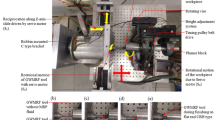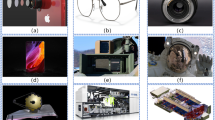Abstract
Electrical discharge milling (ED milling) using spherical electrode is considered to fabricate tungsten carbide (WC) lens moulds for high volume and cost efficient mass production comparing with hemispherical electrode whose wear is noticeably larger. However, micro convexity with dome shape generating in the center of the mould leads to poor surface quality of moulds when using spherical electrode. Therefore, based on boundary layer theory, the forming mechanism of the micro convexity is analyzed in detail by measuring its height and profile by virtue of 3D laser scanning microscope and scanning electron microscope (SEM). The relationship between the boundary layer thickness and the discharge gap is subsequently established, which can be utilized to reduce the convexity to improve the surface quality of lens mould. Then a method to eliminate the micro convexity is proposed. In addition, experiments of different discharge gaps were carried out to confirm the boundary layer theory. Results show that the height of micro convexity can be reduced to 4 μm when the discharge gap was specified to the boundary layer thickness at certain rotational speed.
Similar content being viewed by others
References
Kim, H.-U., Cha, D.-H., Kim, H.-J., and Kim, J.-H., “Rhenium-Iridium Coating Effect of Tungsten Carbide Mold for Aspheric Glass Lens,” Int. J. Precis. Eng. Manuf., Vol. 10, No. 3, pp. 19–23, 2009.
Ko, T. J., Kim, J. H., and Yoon, I. J., “A Study of WC End-Milling Manufacturing and Cutting Ability Evaluation by Using Powder Injection Molding,” Int. J. Precis. Eng. Manuf., Vol. 10, No. 4, pp. 13, 2009.
Yan, J., Zhang, Z., Kuriyagawa, T., and Gonda, H., “Fabricating Micro-Structured Surface by Using Single-Crystalline Diamond Endmill,” The International Journal of Advanced Manufacturing Technology, Vol. 51, No. 9, pp. 957–964, 2010.
Chen, S.-T., Chang, K.-E., Huang, W.-P., Yang, H.-Y., and Lee, X.-M., “Development of a Cost-Effective High-Precision Bench Machine Tool for Multi-Level Micro Aspheric Lighting-Lens Mold Machining,” Int. J. Precis. Eng. Manuf., Vol. 13, No. 12, pp. 2225–2231, 2012.
Reynaerts, D., Meeusen, W., and Van Brussel, H., “Machining of three-Dimensional Microstructures in Silicon by Electro-Discharge Machining,” Sensors and Actuators A: Physical, Vol. 67, Nos. 1-3, pp. 159–165, 1998.
Peng, Z., Wang, Z., Dong, Y., and Chen, H., “Development of A Reversible Machining Method for Fabrication of Microstructures by Using Micro-EDM,” Journal of Materials Processing Technology, Vol. 210, No. 1, pp. 129–136, 2010.
Takino, H. and Hosaka, T., “Shaping of Steel Mold Surface of Lens Array by Electrical Discharge Machining with Single Rod Electrode,” Applied Optics, Vol. 53, No. 33, pp. 8002–8005, 2014.
Liew, P. J., Yan, J., and Kuriyagawa, T., “Carbon Nanofiber Assisted Micro Electro Discharge Machining of Reaction-Bonded Silicon Carbide,” Journal of Materials Processing Technology, Vol. 213, No. 7, pp. 1076–1087, 2013.
Liew, P. J., Yan, J., and Kuriyagawa, T., “Fabrication of Deep Micro-Holes in Reaction-Bonded SiC by Ultrasonic Cavitation Assisted Micro-EDM,” International Journal of Machine Tools and Manufacture, Vol. 76, pp. 13–20, 2014.
Jahan, M. P., Wong, Y. S., and Rahman, M., “A Study on the Fine-Finish Die-Sinking Micro-EDM of Tungsten Carbide Using Different Electrode Materials,” Journal of Materials Processing Technology, Vol. 209, No. 8, pp. 3956–3967, 2009.
Kiyak, M. and Cakır, O., “Examination of Machining Parameters on Surface Roughness in EDM of Tool Steel,” Journal of Materials Processing Technology, Vol. 191, No. 1, pp. 141–144, 2007.
Das, A. K., Kumar, P., Sethi, A., Singh, P. K., and Hussain, M., “Influence of Process Parameters on the Surface Integrity of Micro-Holes of SS304 Obtained by Micro-EDM,” Journal of the Brazilian Society of Mechanical Sciences and Engineering, Vol. 38, No. 7, pp. 2029–2037, 2016.
Iqbal, A. and Khan, A. A., “Modeling and Analysis of Mrr, EWR and Surface Roughness in EDM Milling through Response Surface Methodology,” American Journal of Engineering and Applied Sciences, Vol. 3, No. 4, pp. 611–619, 2010.
Sakiadis, B., “Boundary-layer Behavior on Continuous Solid Surfaces: I. Boundary-Layer Equations for Two-Dimensional and Axisymmetric Flow,” AIChE Journal, Vol. 7, No. 1, pp. 26–28, 1961.
Callegari, A. and Nachman, A., “Some Singular, Nonlinear Differential Equations Arising in Boundary Layer Theory,” Journal of Mathematical Analysis and Applications, Vol. 64, No. 1, pp. 96–105, 1978.
Luo, Y. F., “The Dependence of Interspace Discharge Transitivity Upon the Gap Debris in Precision Electrodischarge Machining,” Journal of Materials Processing Technology, Vol. 68, No. 2, pp. 121–131, 1997.
Acknowledgements
This work has been financed by the National Key Basic Research Programme of China (No. 2015CB059900) and the National Natural Science Foundation of China (No. 51375050).
Author information
Authors and Affiliations
Corresponding author
Rights and permissions
About this article
Cite this article
Zhou, TF., Wang, SB., Liu, X. et al. Micro convexity elimination of tungsten carbide in electrical discharge milling for lens moulds. Int. J. Precis. Eng. Manuf. 18, 1703–1710 (2017). https://doi.org/10.1007/s12541-017-0198-x
Received:
Revised:
Accepted:
Published:
Issue Date:
DOI: https://doi.org/10.1007/s12541-017-0198-x




